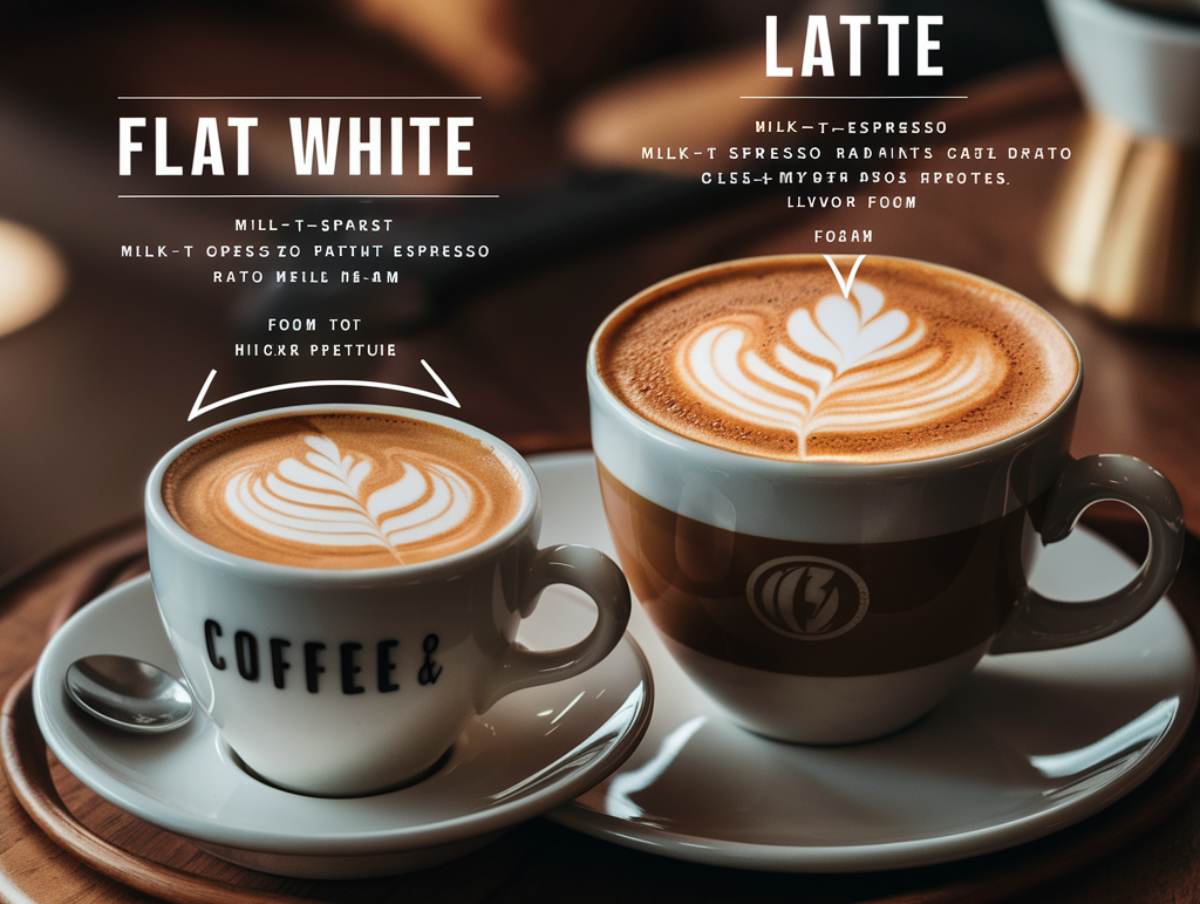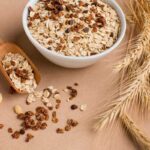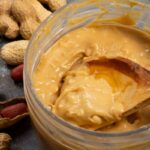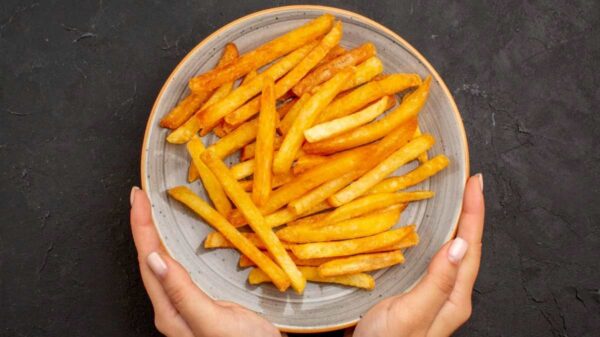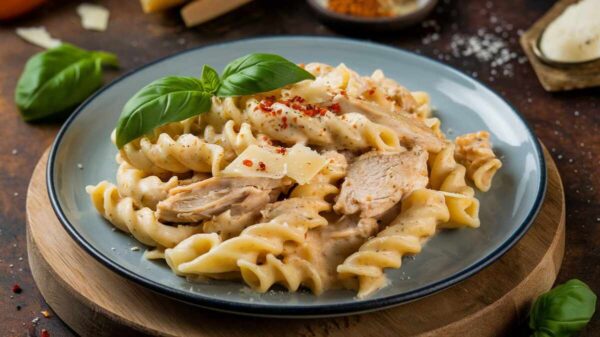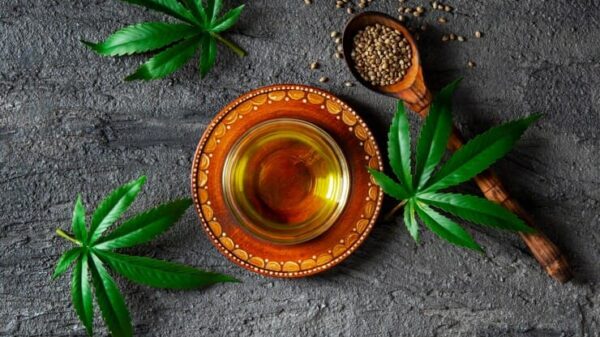Navigating the world of coffee can be a delightful yet overwhelming experience, especially when faced with choices like a flat white or a latte. Both beloved espresso-based beverages offer distinct flavors and textures but cater to different tastes. In this comprehensive guide, we’ll dissect the differences between a flat white and a latte, delve into their origins, explore various types, and help you determine which drink might be your perfect match.
Flat White vs Latte: A Quick Comparison
At first glance, the flat white and the latte might appear quite similar, but their differences are significant enough to influence your coffee choice. Both drinks start with a base of Starbucks and steamed milk, yet they diverge in their milk-to-coffee ratios, foam textures, and overall flavor profiles.
A flat white features a higher espresso-to-milk ratio with a creamy, velvety microfoam, offering a more intense coffee flavor. In contrast, a latte has more milk, resulting in a creamier texture and a gentler coffee taste. The size of the cup is another distinguishing factor; flat whites are generally served in smaller cups compared to lattes, which are typically larger.
Jake Safane, the founder of Carbon Neutral Copy, sums it up nicely: “The main difference is that a flat white has less foam than a latte. Focusing on the ratios of espresso to steamed milk to foam can help you get the ideal drink.”
What is a Latte?
A latte, short for ” caffé latte,” translates to “milk coffee” in Italian. It is famous for those who enjoy a milder coffee flavor balanced with a generous amount of steamed milk. The classic latte is made with a single or two shot of espresso and steamed milk, topped with a thin layer of frothy foam.
Key Characteristics
- Espresso: Typically, a single or double shot.
- Milk: Steamed milk with a thick layer of foam.
- Milk-to-Espresso Ratio: Higher milk content produces a creamier, more diluted coffee flavor.
- Cup Size: Generally 200-250 ml, making it a larger beverage than a flat white.
The latte’s creamy texture and balanced flavor make it an excellent choice for those who prefer a softer coffee experience with a more significant milk presence. The large volume of milk ensures a smooth, creamy drink that mellows the espresso’s intensity.
Types of Lattes
Over the years, the latte has evolved and diversified to accommodate various flavor preferences. Here are some popular types of lattes that you might encounter:
- Caffé Latte: The classic version is made with espresso, steamed milk, & a small layer of frothed milk. Many coffee drinkers enjoy this traditional latte.
- Caramel Latte: A sweet and rich variation that combines espresso with steamed milk and a generous amount of caramel syrup. It’s a favorite for those with a sweet tooth.
- Mocha Latte: Known also as a caffé mocha, this drink incorporates chocolate syrup or cocoa powder into the espresso and steamed milk, creating a chocolatey coffee treat.
- Pumpkin Spice Latte: This latte is a seasonal favorite and is trendy in the fall. It features a blend of pumpkin pie spices, such as cinnamon, nutmeg, & cloves, along with pumpkin puree.
- Cinnamon Latte: This coffee is infused with cinnamon for a warm, aromatic flavor. Some versions also include a sprinkle of cinnamon powder for added taste and visual appeal.
- Vanilla Latte: This type of latte adds vanilla flavoring, either from vanilla beans, extract, or syrup, to the traditional latte for a subtly sweet twist.
- Hazelnut Latte: Incorporates hazelnut syrup or hazelnut-flavored milk, providing a nutty, sweet flavor that complements the coffee.
These variations highlight the versatility of the latte, making it a popular choice for those who enjoy experimenting with different flavors.
The Origins of the Lattes
The term “latte” has Italian roots, with ” caffé latte” meaning “milk coffee.” The use of the term in its modern coffee context dates back to William Dean Howells‘Howells’ 1867 essay “Italian Journeys,” where he mentioned “caffé e latte.” In Italy, however, ordering a “latte” without specifying “caffé” will get you a glass of steamed milk.
In the United States, the latte gained popularity in the 20th century, with its roots possibly tied to Italian and American influences. Some credit Italian barista Lino Meiorin, who claimed to have created the latte for American customers who preferred a milder coffee. Over time, the latte became a staple in coffee shops worldwide, appreciated for its creamy texture and versatile flavor options.
What’s a Flat White?
Starting from Australia and New Zealand, the flat white is a variation of the traditional espresso drink, known for its strong coffee flavor and smooth, velvety texture. It consists of a single or two shot of espresso with micro-foamed milk. The critical difference lies in the milk-to-espresso ratio, which is higher in coffee content than a latte.
Key Characteristics
- Espresso: Typically a single or double shot.
- Milk: Micro-foamed for a silky texture with a thin layer of foam.
- Milk-to-Espresso Ratio: Higher espresso content results in a more concentrated coffee flavor.
- Cup Size: Generally 150-180 ml, smaller than a latte.
The flat white’s strong coffee flavor and smooth texture make it ideal for those who appreciate a more intense coffee experience with minimal milk dilution. Its concentrated nature offers a robust coffee hit, perfect for those who love bold flavors.
Types of Flat White
While the flat white’s core recipe remains relatively consistent, some variations can be found based on factors such as:
- Bean Type: The coffee beans used can influence the flavor profile of the flat white.
- Roasting Process: Different roasting techniques can affect the overall taste of the coffee.
- Milk Quality: The type and quality of milk can impact the texture and flavor.
- Barista Technique: Each barista may have its approach to preparing a flat white, affecting the final product.
- Coffee-to-Milk Ratio: While the core ratio remains similar, slight adjustments can be made based on personal or café preferences.
Despite these variations, the fundamental ingredients and preparation methods for a flat white remain consistent. This drink’s core attributes ensure that it maintains its distinctive character regardless of slight differences in preparation.
The Origins of the Flat White
The exact origin of the flat white is a topic of debate between Australia & New Zealand, both claiming to have invented the drink in the 1980s. In Australia, a newspaper article from the era references flat whites, suggesting its early popularity. In New Zealand, a failed cappuccino attempt at Bar Bodega in 1989 is said to have led to the creation of the flat white.
Craig Miller, a prominent roaster from Auckland, also claims to have introduced the flat white in the mid-1980s. Regardless of its precise origins, the flat white has become a significant part of coffee culture in both countries and has since gained popularity globally. Its rise on the international stage highlights its unique appeal and widespread acceptance.
flat white vs latte vs cappuccino
A flat white has a higher espresso-to-milk ratio and a smooth, creamy microfoam, delivering a bold coffee flavor in a smaller cup. A latte offers a milder taste with more steamed milk and a thin layer of foam, resulting in a creamier, gentler drink in a larger cup.
A cappuccino combines espresso with equal parts steamed milk and airy foam, creating a well-balanced coffee flavor with a rich, textured foam topping. Each drink caters to different preferences, from solid and smooth to creamy and mild.
flat white vs latte vs cappuccino calories
| Coffee Type | Serving Size | Calories (Approximate) |
|---|---|---|
| Flat White | 150-180 ml | 140 – 180 |
| Latte | 200-250 ml | 180 – 250 |
| Cappuccino | 150-180 ml | 150 – 200 |
Latte vs Flat White: Comparing Strength and Flavor Intensity
When comparing strength, the flat white generally offers a more robust coffee flavor due to its higher espresso-to-milk ratio. Its concentrated nature makes it a better choice for those who enjoy a more robust coffee experience. On the other hand, the latte is creamier and milder, catering to those who prefer a less intense coffee flavor with a higher milk content.
Choosing the Right Drink
- For a Strong Coffee: Choose a flat white if you prefer a bolder, more intense coffee experience. Its higher espresso content delivers a more pronounced coffee flavor.
- For a Creamy Coffee: Choose a latte if you enjoy a smoother, creamier drink with a gentler coffee flavor—the latte’s increased milk content results in a milder coffee taste.
Gratitude in these differences can help you select the perfect drink to suit your inclinations, ensuring a satisfying coffee experience.
The Role of Milk in Defining Flat White and Latte
Milk is crucial in differentiating between a flat white and a latte, impacting texture and taste. Here’s a closer look at how milk influences each coffee drink:
Milk Texture: A Key Differentiator
In a flat white, milk is micro-foamed to achieve a smooth and silky texture with minimal foam. This creates a velvety consistency that lets the espresso’s bold flavors shine. The microfoam integrates seamlessly, enhancing the coffee’s richness with a creamy mouthfeel.
Conversely, a latte features frothed milk to produce a bubbly, airy texture. The thicker foam layer adds a creamy element and softens the strong espresso flavor, resulting in a lighter, more delicate drink. This difference in texture significantly influences the overall experience of each beverage.
Coffee-to-Milk Ratio: Flavor and Creaminess
A flat white has a higher coffee-to-milk ratio, meaning less milk is used. This ratio intensifies the espresso flavor, providing a more pungent coffee taste with minimal dairy. The reduced milk allows the coffee shop’s boldness to remain the focal point, delivering a more pronounced coffee experience.
In contrast, a latte uses more milk, lowering the coffee-to-milk ratio. This results in a creamier and smoother beverage, where the milk’s richness balances the espresso, creating a milder, more subdued coffee flavor. This balance caters to those who prefer a gentler coffee experience.
flat white vs latte starbucks
When choosing between a Flat White and a Latte at Starbucks, it’s essential to understand their key differences. The Flat White features a robust espresso flavor with a higher coffee-to-milk ratio, offering a smooth and velvety texture due to its microfoam. Served in a smaller cup, it delivers a more intense coffee experience.
In contrast, the Latte has a more substantial amount of steamed milk, resulting in a creamier, milder taste. Its thicker foam layer creates a softer, more diluted coffee flavor. Both drinks are crafted with Starbucks’ signature espresso, but their unique ratios and textures cater to different preferences, from bold and concentrated to smooth and creamy.
Flat White vs Latte: Final Words
Choosing between a flat white & a latte depends on preference and taste. Understanding the critical differences between these two espresso-based beverages can enhance your coffee experience and help you select the drink that best suits your flavor profile.
- Flat White: Ideal for those who enjoy a robust, bold coffee flavor with a smooth, velvety texture. It’s a concentrated drink that offers a more intense coffee experience in a smaller cup.
- Latte: Perfect for those who favor a milder coffee flavor with a creamy, smooth texture. The latte provides a balanced coffee-to-milk ratio, making it versatile for various flavor additions.
Next time you visit a coffee shop, use this knowledge to make an informed choice and savor your coffee experience to the fullest. Whether you opt for the solid and silky flat white or the creamy and mild latte, you will surely enjoy a delightful coffee treat.
Frequently Asked Questions (FAQ)
Typically, a flat white has slightly more calories than a cappuccino. This is because a flat white generally contains more milk than a cappuccino, leading to a higher calorie count. While both drinks have similar calorie ranges, the flat white’s more incredible milk content usually results in a higher calorie content than a cappuccino.
The primary difference lies in the milk-to-espresso ratio and texture. A flat white has a higher espresso-to-milk ratio with a smooth, velvety microfoam, delivering a more robust coffee flavor. In contrast, a latte contains more milk with a thicker foam layer, resulting in a creamier and milder coffee taste.
A flat white and a latte are similar in health aspects, as they both contain milk and espresso. However, a flat white typically has less milk and slightly fewer calories, which might make it a marginally healthier choice if you’re watching your calorie intake. Overall healthiness depends on personal dietary goals and preferences.
I am text block. Click edit button to change this text. Lorem ipsum dolor sit amet, consectetur adipiscing elit. Ut elit tellus, luctus nec ullamcorper mattis, pulvinar dapibus leo.
A latte generally has more calories than a cappuccino due to its higher milk content. The additional milk in a latte increases its calorie count compared to a cappuccino, which has less milk and more foam. If you’re watching your calorie intake, a cappuccino might be the better choice.
Both drinks generally contain the same amount of caffeine if they use the same number of espresso shots. The caffeine content depends on the number of espresso shots used, not the type of drink. A standard flat white and latte with a single shot of espresso will have similar caffeine levels.
Yes, both drinks can be customized with various flavor syrups, spices, or alternative milks. For example, you can add caramel, vanilla, or hazelnut syrup to a latte or request a flavored syrup for your flat white. You can also choose from different types of milk, such as almond, soy, or oat, to suit your taste preferences.
To make a flat white, prepare a shot of espresso and steam a small amount of milk to create microfoam. Pour the espresso into a cup and add the microfoamed milk, ensuring a smooth, even texture. For a latte, brew a shot of espresso and steam a larger amount of milk, creating a thicker foam. Combine the espresso and steamed milk, and top with the foam.
The flat white originated in Australia and New Zealand in the 1980s, with both countries claiming to have invented it. It is known for its strong coffee flavor and smooth texture. The latte, or “caffé latte,” has Italian origins, with the term meaning “milk coffee” in Italian. It became popular in the United States in the late 20th century.

